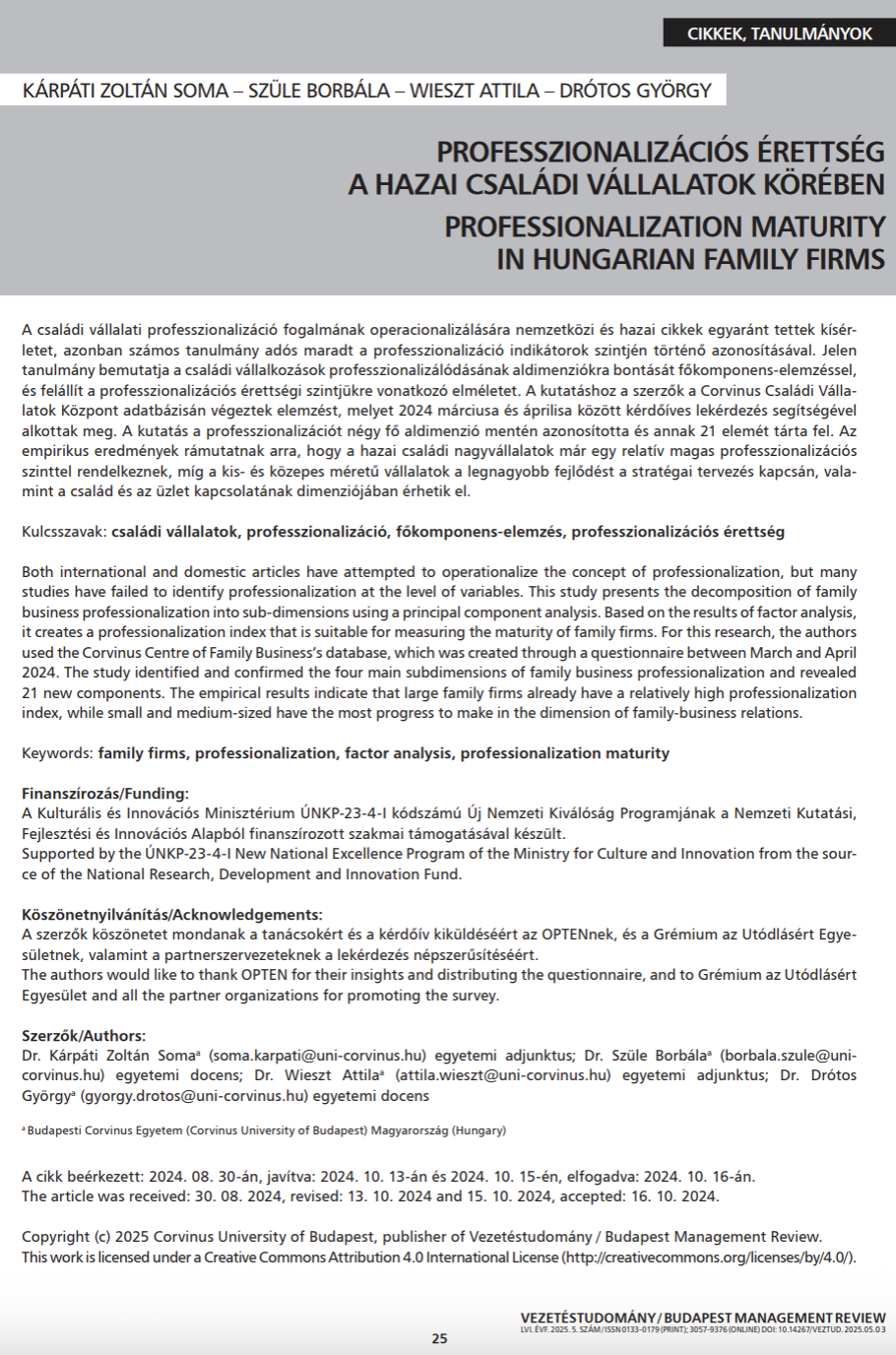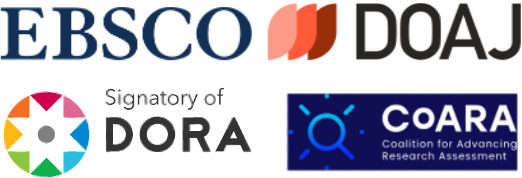Professionalization maturity in Hungarian family firms
DOI:
https://doi.org/10.14267/VEZTUD.2025.05.03Keywords:
family firms, professionalization, factor analysis, professionalization maturityAbstract
Both international and domestic articles have attempted to operationalize the concept of professionalization, but many studies have failed to identify professionalization at the level of variables. This study presents the decomposition of family business professionalization into sub-dimensions using a principal component analysis. Based on the results of factor analysis, it creates a professionalization index that is suitable for measuring the maturity of family firms. For this research, the authors used the Corvinus Centre of Family Business’s database, which was created through a questionnaire between March and April 2024. The study identified and confirmed the four main subdimensions of family business professionalization and revealed 21 new components. The empirical results indicate that large family firms already have a relatively high professionalization index, while small and medium-sized have the most progress to make in the dimension of family-business relations.
Downloads
References
Arteaga, R., & Menéndez-Requejo, S. (2017). Family Constitution and Business Performance: Moderating Factors. Family Business Review, 30(4), 320-338. https://doi.org/10.1177/0894486517732438
Bogdány, E., Szépfalvi, A., & Balogh, Á. (2019). Hogyan tovább családi vállalkozások? – Családi vállalkozások utódlási jellemzői és nehézségei. Vezetéstudomány, 50(2), 72-85. https://doi.org/10.14267/ VEZTUD.2019.02.06
Camfield, C., & Franco, M. (2019). Professionalisation of the Family Firm and Its Relationship with Personal Values. The Journal of Entrepreneurship, 28(1), 144-288. https://doi.org/10.1177/0971355718810291
Cattaneo, C. & Bassani, G. (2020). Professionalization and Managerialization in Family Firms: A Still Open Issue. In Leotta, A. (Eds.), Management Controlling and Governance of Family Businesses: Contributions to Management Science (pp. 29-49). Springer. https://doi.org/10.1007/978-3-030-47741-7_3
Chang, S.J., & Shim, J. (2015). When does transitioning from family to professional management improve firm performance? Strategic Management Journal, 36(9), 1297-1316. https://doi.org/10.1002/smj.2289
Christmann, A., & Van Aelst, S. (2006). Robust estimation of Cronbach’s alpha. Journal of Multivariate Analysis, 97(7), 1660-1674. https://doi.org/10.1016/j.jmva.2005.05.012
Chua, J.H., Chrisman, J.J., & Bergiel, E.B. (2009). An Agency Theoretic Analysis of the Professionalized Family Firm. Entrepreneurship Theory and Practice, 33(2), 355-372. https://doi.org/10.1111/j.1540-6520.2009.00294.x
Cronbach, L.J. (1951). Coefficient alpha and the internal structure of tests. Psychometrika, 16, 297-334. https://doi.org/10.1007/BF02310555
De Kok, J.M.P., Uhlaner, L.M., & Thurik, A.R. (2006). Pro-fessional HRM Practices in Family Owned‐Managed Enterprises. Journal of Small Business Management, 44(3), 441-460. https://doi.org/10.1111/j.1540-627X.2006.00181.x
de Leeuw, J. (2006). Principal component analysis of binary data by iterated singular value decomposition. Computational Statistics & Data Analysis, 50(1), 21-39. https://doi.org/10.1016/j.csda.2004.07.010
Dekker, J.C., Lybaert, N., Steijvers, T., Depaire, B., & Mercken, R. (2013). Family Firm Types Based on the Professionalization Construct: Exploratory Research. Family Business Review, 26(1), 81-99. https://doi.org/10.1177/0894486512445614
Dekker, J., Lybaert, N., Steijvers, T., & Depaire, B. (2015). The effect of family business professionalization as a multidimensional construct on firm performance. Journal of Small Business Management, 53(2), 516-538. https://doi.org/10.1111/jsbm.12082
Deng, L. & Chan, W. (2017). Testing the difference between reliability coefficients alpha and omega. Educational and Psychological Measurement, 77(2), 185-203. https://doi.org/10.1177/0013164416658325
Dyer, W.J. (1989). Integrating Professional Management into a Family Owned Business. Family Business Review, 2(3), 221-236. https://doi.org/10.1111/j.1741-6248.1989.00221.x
Fabel, O., Mináriková, D., & Hopp, C. (2022). Differences and similarities in executive hiring decisions of family and nonfamily firms. Journal of Family Business Strategy, 13(2), 1-15. https://doi.org/10.1016/j.jfbs.2021.100481
Fang, H., Memili, E., Chrisman, J.J., & Welsh, D.H. (2012). Family Firm’s Professionalization: Institutional Theory and Resource-Based View Perspectives. Small Business Institute Journal, 8(2), 12-34.
Fellman, S. (2013). Managing Professionalization in Family Business – Transforming Strategies for Managerial Succession and Recruitment in Family Firms in the Twentieth Century in The Endurance of Family Businesses a Global Overview. In Fernandez Perez, P., & Colli, A. (Eds.), The Endurance of Family Businesses: A Global Overview (pp. 248-282). Cambridge University Press. https://doi.org/10.1017/CBO9781139794848.015
Felsmann, B., Ferincz, A., & Kárpáti, Z. (2022). Erőforrások és képességek a vállalati versenyképesség tükrében: Egy empirikus vizsgálat tanulságai. Vezetéstudomány, 53(4), 2–16. https://doi.org/10.14267/VEZTUD.2022.04.01
Flamholtz, E.G., & Randle, Y. (2007). Growing Pain - Transitioning from an Entrepreneurship to a Professionally Managed Firm. Jossey-Bass.
Heidrich, B., & Vajdovich, N. (2021). Quo vadis? – A családi vállalkozások összetett célrendszerének elemzése. Vezetéstudomány, 52(11), 13–27. https://doi.org/10.14267/VEZTUD.2021.11.02
Gersick, K.E., & Feliu, N. (2014). Governing the family enterprise: Practices, performance, and research. In The SAGE handbook of family business (pp. 196-225). SAGE Publication. https://doi.org/10.4135/9781446247556.n11
Gnan, L., Montemerlo, D., & Huse, M. (2013). Governance Systems in Family SMEs: The Substitution Effects between Family Councils and Corporate Governance Mechanisms. Journal of Small Business Management, 53(2), 355–381. https://doi.org/10.1111/jsbm.12070
Gomez-Mejia, L.R., Cruz, C., Berrone, P., & De Castro, J. (2011). The Bind that Ties: Socioemotional Wealth Preservation in Family Firms. The Academy of Management Annals, 5(1), 653–707. https://doi.org/10.5465/19416520.2011.593320
Kaehr Serra, C, & Thiel, J. (2019). Professionalizing entrepreneurial firms: Managing the challenges and outcomes of founder-CEO succession. Strategic Entrepreneurship Journal, 13, 379–409. https://doi.org/10.1002/sej.1329
Kárász, J.T., Nagybányai Nagy, O., Széll, K., & Takács, Sz. (2022). Cronbach-alfa: vele vagy nélküle? Magyar Pszichológiai Szemle, 77(1), 81–98. https://doi.org/10.1556/0016.2022.00004
Kárpáti, Z. (2021). Családi vállalatok professzionalizálódása – Szisztematikus szakirodalmi áttekintés. Vezetéstudomány, 52(3), 53–65. https://doi.org/10.14267/VEZTUD.2021.03.05
Kárpáti, Z. & Drótos, G. (2023). Hogyan professzionalizáljuk a vállalkozásunkat? Egy longitudinális esettanulmány tapasztalatai egy hazai közepes méretű családi vállalkozás példáján keresztül. Vezetéstudomány, 54(2), 53–67. https://doi.org/10.14267/VEZTUD.2023.02.05
Kárpáti, Z., & Ferincz, A. (2024). A professzionalizáció szerepe a hazai közepes méretű családi vállalatok versenyképességében. Vezetéstudomány, 55(3), 2–13. https://doi.org/10.14267/VEZTUD.2024.03.01
Kárpáti, Z., Ferincz, A., & Felsmann, B. (2024). Relationship between different resource and capability configurations and competitiveness – comparative study of Hungarian family and nonfamily firms. Journal of Family Business Management, 14(4), 781-801. https://doi.org/10.1108/JFBM-08-2023-0145
Kline, R.B. (2016). Principles and practice of structural equation modeling (4th edition). The Guilford Press. Központi Statisztikai Hivatal. (2024). A vállalkozások teljesítménymutatói kis- és középvállalkozási kategória szerint. https://www.ksh.hu/stadat_files/gsz/hu/gsz0018.html
Li, X., & Dubes, R.C. (1989). A probabilistic measure of similarity for binary data in pattern recognition. Pattern Recognition, 22(4), 397-409. https://doi.org/10.1016/0031-3203(89)90049-6
Hair, J., Black, W., Babin, B., & Anderson, R.E. (2019). Multivariate Data Analysis (8th edition). Cengage Learning.
Hall, A. & Nordqvist, M. (2008). Professional Management in Family Businesses: Toward an Extended Understanding. Family Business Review, 21(1), 51-69. https://doi.org/10.1111/j.1741-6248.2007.00109.x
Hiebl, M.R., & Mayrleitner, B. (2019). Professionalization of management accounting in family firms: the impact of family membersfamily members. Review of Managerial Science, 13(5), 1037-1068. https://doi.org/10.1007/s11846-017-0274-8
Le Breton-Miller, I., & Miller, D. (2006). Why Do Some Family Businesses Out-Compete? Governance, Long- Term Orientations, and Sustainable Capability. Entrepreneurship Theory and Practice, 30(6), 731-746. https://doi.org/10.1111/j.1540-6520.2006.00147.x
Madison, K., Daspit, J.J., Turner, K., & Kellermans, F.W. (2018). Family firm human resource practices: Investigating the effects of professionalization and bifurcation bias on performance. Journal of Business Research, 84, 327-336. https://doi.org/10.1016/j.jbusres.2017.06.021
Michiels, A., Uhlaner, L., & Dekker, J. (2017). The effect of family business professionalization on dividend payout. Journal of Small Business and Enterprise Development, 24(4), 971-990. https://www.doi.org/10.1108/JSBED-01-2017-0023
Nagy, A.Sz., & Tobak, J. (2017). Családi vállalkozások vezetési és utódlási kérdései. TAYLOR, 9(2), 188-96. https://www.iskolakultura.hu/index.php/taylor/article/view/13116
Németh, K., & Németh, S. (2018). Professzionalizálódó családi vállalkozások Magyarországon. Prosperitas, 5(3), 24–47. https://doi.org/10.31570/prosp_2018_03_2
Noguchi, K., Abel, R.S., Marmolejo-Ramos, F., & Konietschke, F. (2020). Nonparametric multiple comparisons. Behavior Research Methods, 52, 489–502. https://doi.org/10.3758/s13428-019-01247-9
Nordqvist, M., Wennberg, K., Bau, M., & Hellerstedt, K. (2013). An entrepreneurial process perspective on succession in family firms. Small Business Economics, 40(4), 1087-1122. https://doi.org/10.1007/s11187-012-9466-4.
Noszkay, E. (2017). Tapasztalatok a családi vállalkozások átörökítésének dilemmái kapcsán. Vezetéstudomány, 48(6-7), 64-72. https://doi.org/10.14267/VEZTUD.2017.06.08
Ortiz, J., & Gargallo-Castel, A. (2024). Innovation and firm performance: influence of ownership and professionalization. Economics of Innovation and New Technology, 1-23. https://doi.org/10.1080/10438599.2024.2353296
Polat, G. (2021). Advancing the multidimensional approach to family business professionalization. Journal of Family Business Management, 11(4), 555-571. https://doi.org/10.1108/JFBM-03-2020-0020
Polat, G., & Benligiray, S. (2022). The impact of family business professionalization on financial performance: a multidimensional approach. Journal of Small Business and Enterprise Development, 29(7), 1149-1175. https://doi.org/10.1108/JSBED-11-2021-0437
Sallay, V., Wieszt, A., Varga, Sz., & Martos, T. (2024). Balancing identity, construction, and rules: Family relationship negotiations during first-generation succession in family businesses. Journal of Business Research, 174, 1-20, https://doi.org/10.1016/j.jbusres.2023.114483.
Sharma, P. (2004). An overview of the field of family business studies: current status and directions for the future. Family Business Review, 17(1), 1-36. https://doi.org/10.1111/j.1741-6248.2004.00001.x
Sharma, P., Chrisman, J. J., Pablo, A. L., & Chua, J. H. (2001). Determinants of initial satisfaction with the succession process in family firms: A conceptual model. Entrepreneurship Theory and Practice, 25(3), 17- 35. https://doi.org/10.1177/104225870102500302
Songini, L. (2006). The professionalization of family firms: theory and practice. In P.Z. Poutziouris, K.X. Smyrnios, & S.B. Klein (Eds.), Handbook of Research on Family Business (pp. 269-297). Edward Elgar Publishing Limited. https://doi.org/10.4337/9781847204394.00026
Songini, L., Armenia, S., Morelli, C., & Pompei, A. (2024). Managerialization, professionalization and firm performance in family business: A Systems Thinking perspective. Systems Research and Behavioral Science, 41(1), 100-118. https://doi.org/10.1002/sres.2935
Stewart, A., & Hitt, M.A. (2012). Why can’t a family business be more like a nonfamily business? Modes of professionalization in family firms. Family Business Review, 25(1), 58-86. https://doi.org/10.1177/0894486511421665
Suess, J. (2014). Family governance – Literature review and the development of a conceptual model. Journal of Family Business Strategy, 5(2), 138-155. https://doi.org/10.1016/j.jfbs.2014.02.001
Szüle, B. (2017). Comparison of goodness measures for linear factor structures. Hungarian Statistical Review, Special number 2, 147-163. https://doi.org/10.20311/stat2017.k21.en147
Vajda, É., Wieszt, A., & Anand, A. (2024). Fair play in family firms: examining the perceived justice of performance management systems. Journal of Family Business Management, 14(6), 1065-1083. https://doi.org/10.1108/JFBM-05-2024-0094
Vajdovich, N., Heidrich, B., Németh, S., & Németh, K. (2022). From here to eternity: An empirical analysis of the goal system of family wineries. Entrepreneurial Business and Economics Review, 10(4), 155-179. https://doi.org/10.15678/EBER.2022.100410
Vargha, A. (2002). Független minták összehasonlítása új rangsorolásos eljárásokkal. Statisztikai Szemle, 80(4), 328-353.
Waldkirch, M., Melin, L., & Nordqvist, M. (2017). When the cure turns counterproductive: Parallel professionalization in family firms. Academy of Management Proceedings, 1. https://doi.org/10.5465/ambpp.2017.50
Waldkirch, M. (2020). Non-family CEOs in family firms: Spotting gaps and challenging assumptions for a future research agenda. Journal of Family Business Strategy, 11(1), 100305. https://www.doi.org/ 10.1016/j.jfbs.2019.100305
Warrick, D.D. (2017). What leaders need to know about organizational culture. Business Horizons, 60(3), 395- 404. https://doi.org/10.1016/j.bushor.2017.01.011
Wieszt, A., Martos, T., Sallay, V., Varga, Sz., & Vékás, P. (2021). Családi vállalatok utódlása Magyarországon (Kutatási jelentés). Budapesti Corvinus Egyetem. https://unipub.lib.uni-corvinus.hu/7092/1/ResearchReport_hu.pdf
Zimmerman, D.W. (2006). Two separate effects of variance heterogeneity on the validity and power of significance tests of location. Statistical Methodology, 3(4), 351-374. https://doi.org/10.1016/j.stamet.2005.10.002
Zhang, J., & Ma, H. (2009). Adoption of professional management in Chinese family business: A multilevel analysis of impetuses and impediments. Asia Pacific Journal of Management, 26(1), 119-139. https://doi.org/10.1007/s10490-008-9099-y

Downloads
Published
How to Cite
Issue
Section
License
Copyright (c) 2025 Corvinus University of Budapest, publisher of Vezetéstudomány / Budapest Management Review

This work is licensed under a Creative Commons Attribution 4.0 International License.
Authors assign copyright to Vezetéstudomány / Budapest Management Review. Authors are responsible for permission to reproduce copyright material from other sources.

